Root canal treatment is the removal of the tooth's pulp, a small, thread-like tissue in the center of the tooth. Once the damaged, diseased or dead pulp is removed, the remaining space is cleaned, shaped and filled. This procedure seals off the root canal. Years ago, teeth with diseased or injured pulps were removed. Today, root canal treatment saves many teeth that would otherwise be lost.
The most common causes of pulp damage or death are:
- A cracked tooth
- A deep cavity
- An injury to a tooth, such as a severe knock to the tooth, either recent or in the past
Once the pulp is infected or dead, if left untreated, pus can build up at the root tip in the jawbone, forming an abscess. An abscess can destroy the bone surrounding the tooth and cause pain.
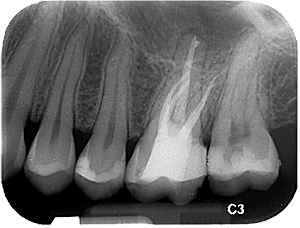
How is a Root Canal Done?
Root canal treatment consists of several steps that take place over several office vRoot canal treatment consists of several steps that take place over single / several office visits, depending on the situation. These steps are:
- First, an opening is made through the back of a front tooth or the crown of a molar or pre-molar. re cleaned, enlarged and shaped in preparation for being filled.
- If more than one visit is needed, a temporary filling is placed in the crown opening to protect the tooth between dental visits.
- The temporary filling is removed and the pulp chamber and root canal permanently filled. A tapered, rubbery material called gutta-percha is inserted into each of the canals and is often sealed into place with cement. Sometimes a metal or plastic rod is placed in the canal for structural support.
- In the final step, a crown is usually placed over the tooth to restore its natural shape and appearance. If the tooth is very broken down, a post may be required to build it up prior to placing a crown.
How Long Will the Restored Tooth Last?
Your treated and restored tooth/teeth can last a lifetime with proper care. Because tooth decay can still occur in treated teeth, good oral hygiene and regular dental exams are necessary to prevent further problems.
As there is no longer a pulp keeping the tooth alive, root-treated teeth can become brittle and are more prone to fracture. This is an important consideration when deciding whether to crown or fill a tooth after root canal treatment.
To determine the success or failure of root canal treatment, the most relied-upon method is to compare new X-rays with those taken prior to treatment. This comparison will show whether bone continues to be lost or is being regenerated.
Sometimes called a fixed partial denture, a bridge replaces missing teeth with artificial teeth, looks great, and literally bridges the gap where one or more teeth may have been. The restoration can be made from alloys, porcelain or a combination of these materials and is bonded onto surrounding teeth for support.
Unlike a removable bridge, which you can take out and clean, a fixed bridge can only be removed by a dentist. An implant bridge attaches artificial teeth directly to the jaw or under the gum tissue. Depending on which type of bridge you require, its success depends on its foundation. So it's very important to keep your remaining teeth healthy and strong.
You may also need a crown to cover a tooth and restore it to its normal shape and size. A crown can make your tooth stronger and improve its appearance. It can cover and support a tooth with a large filling when there isn't enough tooth left. It can be used to attach a bridge, protect a weak tooth from breaking or restore one that's already broken. A crown is a good way to cover teeth that are discolored or badly shaped. It's also used to cover a dental implant.


What are Dental Crowns and Tooth Bridges?
Both crowns and most bridges are fixed prosthetic devices. Unlike removable devices such as dentures, which you Both crowns and most bridges are fixed prosthetic devices. Unlike removable devices such as dentures, which you can take out and clean daily, crowns and bridges are cemented onto existing teeth or implants, and can only be removed by a dentist.
How Long do Crowns and Bridges Last?
While crowns and bridges can last a lifetime, they do sometimes come loose or fall out. The most important step you can take to ensure the longevity of your crown or bridge is to practice good oral hygiene. A bridge can lose its support if the teeth or bone holding it in place are damaged by dental disease. Keep your gums and teeth healthy by Brushing with fluoride toothpaste twice a day and flossing daily. Also see your dentist and hygienist regularly for checkups and professional cleanings. To prevent damage to your new crown or bridge, avoid chewing hard foods, ice or other hard objects.
Crowns
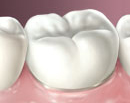 |
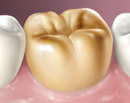 |
| Full porcelain fused to metal. | Full cast gold crown. |
Bridges
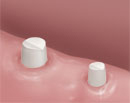 |
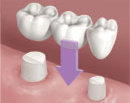 |
 |
| Teeth around the space are prepared. | The bridge is mounted and adjusted for fit and comfort. | The bridge is cemented into position. |
Wisdom teeth are the last molars on each side of the jaws. They are also the last teeth to emerge, or erupt, usually when a person is between 16 and 20.
Since wisdom teeth are the last permanent teeth to come in, or erupt, there is often not enough room left in your mouth to accommodate them. This can lead to wisdom teeth that are impacted, teeth that are trapped beneath the gum tissue by other teeth or bone. If teeth are impacted, swelling and tenderness may occur.
Wisdom teeth that only partially emerge or come in crooked can also lead to painful crowding and disease. Since teeth removed before age 20 have less developed roots and fewer complications, the American Dental Association recommends that people between 16 and 19 have their wisdom teeth evaluated to see if they need to be removed.
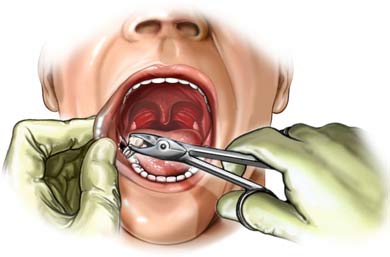
How are Wisdom Teeth Removed?
A tooth extraction is a relatively routine procedure. Your dentist or a dental specialist, called an oral surgeon, will recommend either "going to sleep" using general anesthesia, or numbing this area in your mouth with a local anesthesia such as Novocain®.
After the tooth (or teeth) is removed, you may be asked to bite down softly on a piece of gauze for 30 to 45 minutes after you leave the office, to limit any bleeding that may occur. Some pain and swelling may occur but it will normally go away after a few days; however, you should call your dentist if you have prolonged or severe pain, swelling, bleeding or fever.
Removal of wisdom teeth due to crowding or impaction should not affect your bite or oral health in the future.
 |
 |
 |
|
Horizontal Impaction |
Angular Impaction |
Vertical Impaction |

